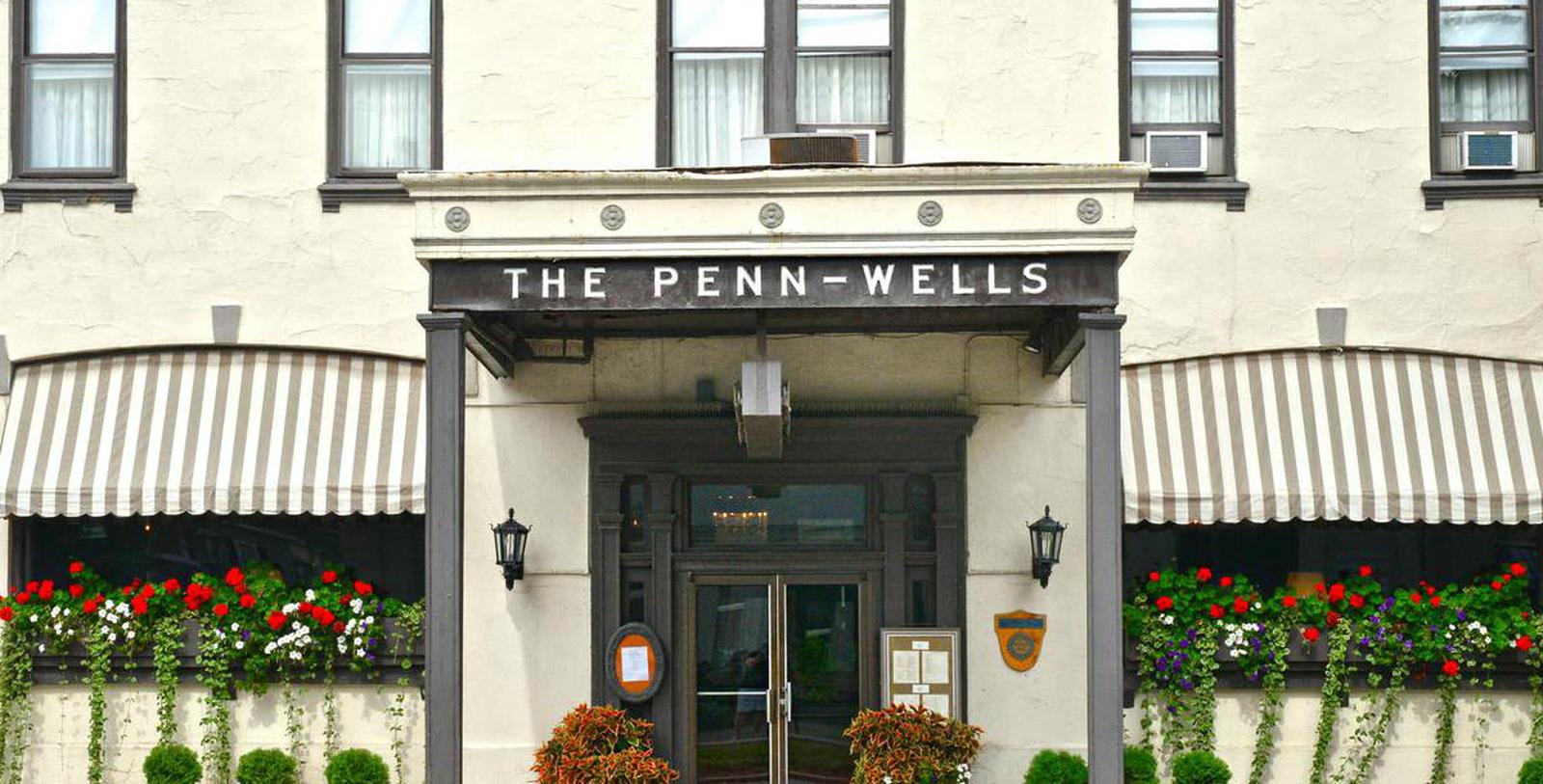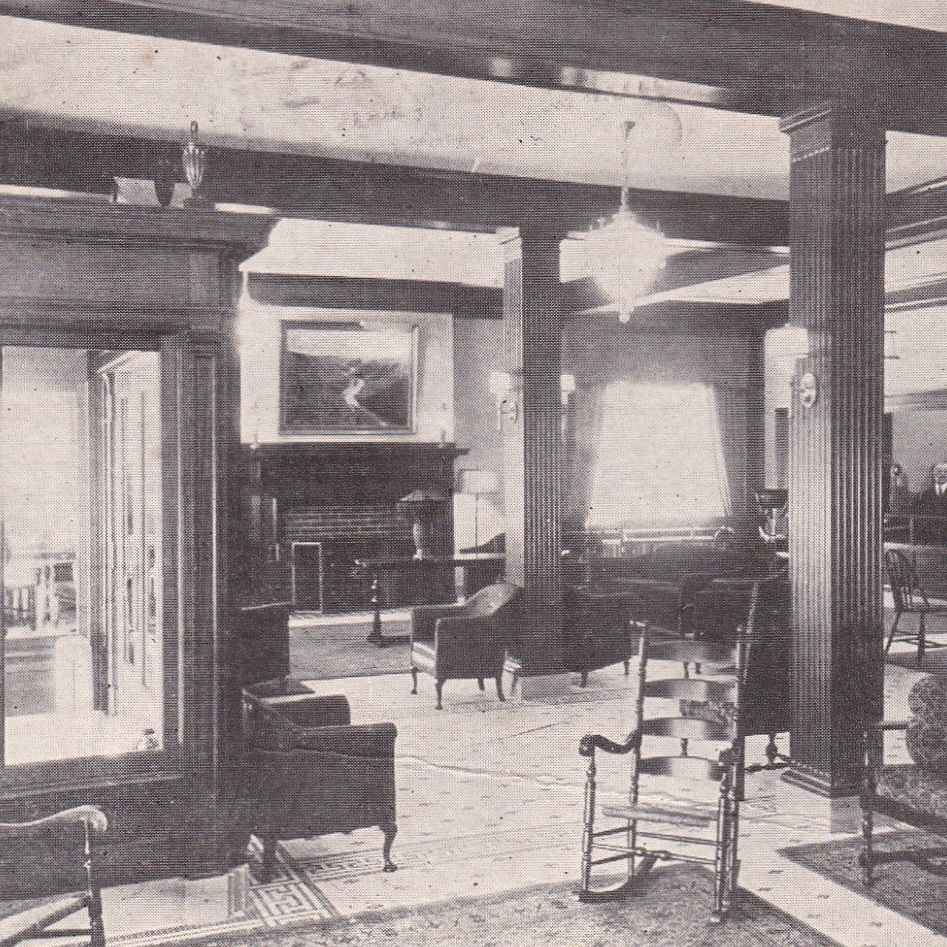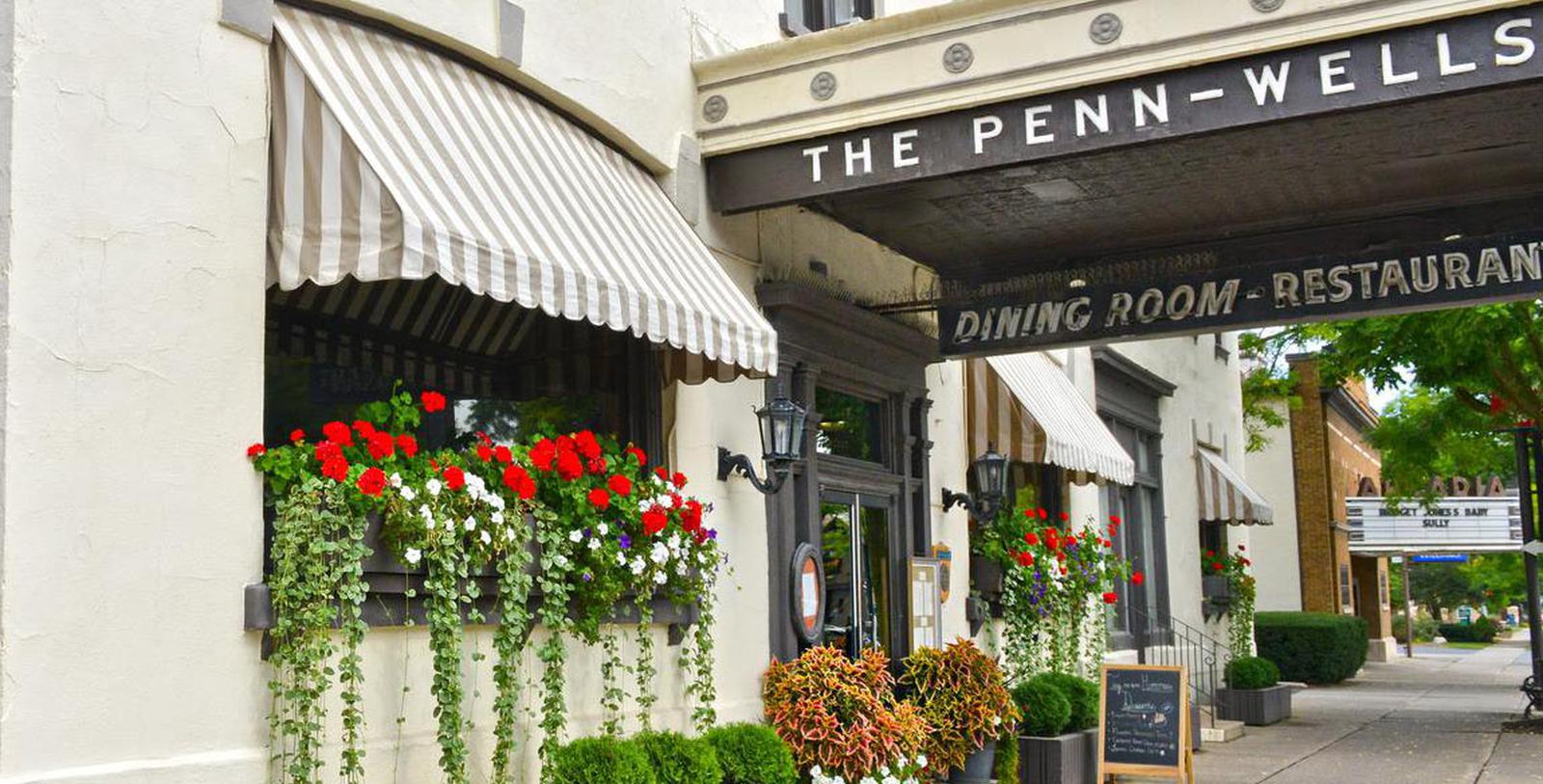Receive for Free - Discover & Explore eNewsletter monthly with advance notice of special offers, packages, and insider savings from 10% - 30% off Best Available Rates at selected hotels.
history
Discover the Penn Wells Hotel with its cozy and traditional guestrooms with high ceilings and mahogany woodwork. The hotel stands among the gas lamps of Main Street in Wellsboro.
Penn Wells Hotel, a member of Historic Hotels of America since 2017, dates back to 1869.
VIEW TIMELINEA member of Historic Hotels of America since 2017, the Penn Wells Hotel was originally constructed at a time when the United States was defined by great economic prosperity, industrial expansion, and significant social reform. The Penn Wells Hotel sits on the site of Wellsboro's first tavern, the “United States House,” which opened in 1816. But when the original structure was destroyed by a fire five decades later, Albert Pitkin “A.P.” Cone set about developing his own hotel upon the site. Christened as the “Penn Wells Hotel,” it immediately became one of the most active business in all of Wellsboro. After Cone’s death, the hotel underwent a period of fluid ownership, with B.B. Holiday and Thomas Veazie operating it at various times throughout the 1870s and 1880s. (Both men operated the building as the “Holiday Inn” and the “Hotel Parkhurst House,” respectively.) Then, in 1885, J.S. Cole purchased the rights to the business and took over its operation. Now known as “Coles House,” Coles managed the hotel alongside his brother, William. Nevertheless, Coles fell ill and passed away during the 1890s, leaving the Coles House to his beloved brother. In J.S.’s honor, William went about thoroughly renovating the structure, in which he painted the woodwork red, refaced the original brick, installed a tin roof, and added a steel ceiling to the dining room. The younger Coles even began operating a new bar around the end of the decade.
Tragedy struck during the early months of 1906, when a major structural calamity befell the hotel. While every floor inside the edifice had been damaged, no guests were harmed. Undeterred, William Coles completely renovated the structure, building it back stronger than ever. He continued to operate the Coles House for another 14 years, right up until his own death in 1920. Several months later, Clark B. Richardson purchased the Coles House from the Coles’ estate and changed its name to the “Wellsboro Inn.” Despite Richardson’s enthusiasm, the Wellsboro Inn evenutally closed in the autumn of 1925. In response, 60 local business leaders formed the “Wellsboro Hotel Company” as a means of saving the historic hotel. Notable figures included Leonard Harrison—who would personally buy one-sixth of the subscription of shares and bonds issued to support the hotel’s renewal—former Congressman Horace Packer, and Claude E. Bennett of Tioga Savings & Trust. Bennet himself would even serve as the first Wellsboro Hotel Company president. Together, the community began its own restoration of the site. New gorgeous flooring was laid upon the deteriorating foundation and state-of-the plumbing systems were installed all over the interior. In fact, the brass pipes helped administer a process of thermo circulation that distributed hot water consistently throughout the hotel.
The reconstructed Penn Wells reopened with 55 brilliant guestrooms, of which 42 contained private baths. The revived hotel flourished for decades thereafter, with a reporter for the Philadelphia Inquirer even calling it “the gem of the Roosevelt Highway.” A regular bus service soon ran from New York’s Waldorf-Astoria, while other charters brought traffic consistently from Philadelphia and Pittsburgh. The Penn Wells was also a popular stop along the famous Greyhound route that ran between New York and Chicago. Some of those buses even brought renowned celebrities to the hotel, including the comedian Groucho Marx! And during World War II, the hotel hosted Joan Crawford, who stayed at the hotel when she came to see the Pine Creek Gorge in 1943. (The Penn Wells also took on patriotic duties, housing the Ladies Room, where local women sewed clothes for the needy, and an observation post on the roof, built for detecting enemy aircraft.) Nevertheless, the Penn Wells continued to occupy an important place in the local community, entertaining all kinds of dinners, concerts, and Saturday evening hoedowns. Even the local Corning Glass plant held its annual holiday party at the hotel, in which it presented the business with a unique American flag constructed of 1,438 glass Christmas ornaments! The Penn Wells Hotel continues to be among the most important fixtures in Wellsboro today, as well as one of the most luxurious destinations in al of Pennsylvania.
-
About the Location +
The Penn Wells Hotel is one of the most significant historical landmarks that resides within the Wellsboro Historic District. In fact, the U.S. Department of the Interior listed it as one of the area’s contributing structures back in 2004. The district itself resides in the heart of Wellsboro, composed of some 530 structures that harken all the way back to the early 19th century. It also doubles as the original nucleus for the borough, which Benjamin Wister Morris originally settled in 1806. An agent for the Pine Creek Land Company, Morris first arrived in the area from Philadelphia alongside his wife, Mary Wells Morris, and their two children, Samuel and Rebecca. When they constructed their simple log cabin later that year, it was the only dwelling in the region at the time. Then in 1807, with the Morris family still the only Euro-Americans living in the area, Wellsboro—apparently named after Benjamin’s wife—was designated as the county seat for Tioga County. Wellsboro’s location at the intersection of the Morris State Road, as well as the East and West State roads, made it a prime crossroads, even in the early 1800s. As such, Hobart Graves, another early resident, constructed a country tavern near the juncture after Tioga County’s sheriff, Alpheus Cheney, purchased the land from Samuel Morris in 1816. Since then, the site has always been occupied by a similar structure, whether it be an inn or a hotel.
Settlement around Wellsboro remained slow for some time until the eve of the American Civil War, when Pennsylvania emerged as one of the leading national producers of lumber. The timber industry soon became ubiquitous throughout northern Pennsylvania, first appearing in places like neighboring Lycoming County before emerging in places like Wellsboro. Among the very first individuals to set up a lumber operation in Wellsboro was Leonard Harrison, who conducted large-scale logging operations near Marsh and Pine Creeks. The proliferation of the lumber industry evenutally attracted various railroad lines to establish routes through the borough, including the Lawrenceville and Wellsboro Railroad, as well as the Jersey Shore, Pine Creek, & Buffalo Railroad. The boom in lumber made Wellsboro a very prosperous town for a while, attracting all kinds of people from various walks of life. Many beautiful residential homes debuted downtown as such, which displayed a myriad of architectural styles that ranged from Colonial Revival to French Second Empire. (Other forms included Queen Anne, Italianate, and even Neoclassical.) Additional industries also opened in Wellsboro around the start of the next century, such as coal shipping companies and glass manufacturers. In fact, the local factory operated by the Corning Glass Works became one of the first in the whole United States to produce light bulbs for mass consumption!
In World War II, Wellsboro was actually designated as a possible target for German bombing because of the contributions made by the local Corning Glass factory. An observation post was built on the roof of the Penn Wells Hotel and staffed by local volunteers to detect approaching enemy warplanes. The glass plant began producing Christmas bulbs In addition to its military support efforts, since the nation’s supply had historically come from Germany. Perhaps the greatest testimony to the factory’s newfound talent for producing holiday ornaments was when it produced an American flag composed of 1,438 Christmas bulbs. Hung on display in the Penn Wells Hotel, the flag quickly became a national icon. The beautiful exhibition piece was even featured in Life magazine during the 1960s! Today, though, Wellsboro is known for being one of the commonwealth’s most celebrated vacation hotspots. It has specifically found an audience among those who enjoy outdoor activities, for Wellsboro is close to the iconic Pine Creek Gorge, otherwise referred to as Pennsylvania’s “Grand Canyon.” Located within the verdant Tioga State Forest, the gorge offers unobstructed views of the picturesque Allegheny Plateau for miles. But cultural heritage travelers have also found Wellsboro to be filled with many exciting attractions, too. Among the most noteworthy places to visit in Wellsboro are the Acadia Theatre. Opened in 1921, this spectacular venue rose to fame when it hosted the world premiere of Top O’ the Morning in 1949. Few places in northern Pennsylvania can rival Wellsboro’s fascinating history.
-
About the Architecture +
When local businesspeople renovated the Penn Wells Hotel at the height of the Roaring Twenties, they chose to recreate its historic façade with Art Moderne-style architecture. Art Moderne is a close relative to the Art Deco style of architecture that swept through the nation in the 1920s and 1930s. Like its cousin, the form originally emerged from a desire among architects to find architectural inspiration from previous historical examples. It specifically rejected the rustic, minimalism of the Arts & Crafts movement that had emerged around the same time. More importantly, they hoped that their ideas would better reflect the technological advances of the modern age. As such, historians today often consider Art Deco and Art Moderne to be a part of the much wider proliferation of cultural “Modernism” that first manifested at the dawn of the 20th century. Art Deco itself as a style that first became popular in 1922, when Finnish architect Eliel Saarinen submitted the first blueprints that featured the form for contest to develop the headquarters of the Chicago Tribune. While his concept did not win, they were widely publicized, nonetheless. Architects in both North America and Europe soon raced to copy his format, giving birth to Art Deco architecture. The international acceptance of Art Deco had risen so quickly that it was the central theme to the renowned Exposition des Art Decoratifs held in Paris a few years later.
But as the Great Depression surged throughout the United States in the early 1930s, American architects began to question the ostentatious nature of Art Deco design principles. Art Deco used a sleek, linear appearance that embraced ornate geometric decorations like chevrons and zigzags. But with the financial hardships of the depression constraining the budgets of architects worldwide, they started to “streamline” elements of Art Deco architecture into a more modest form. Called “Art Moderne,” this new variation of Art Deco relied upon an aerodynamic “pure-line” concept that reflected the reigning scientific attitudes about motion. The reason for adopting such ideals reflected the perception that modernity was unfolding at an unprecedented rate. Surfaces became plainer, while the exterior ornamentations were largely abandoned in favor of rounded lines and curves. Stucco served as the primary building ingredient for Art Moderne structures, although smooth-faced stone and polychromatic metals were utilized, too. Art Moderne also typically called for smaller structures, which enabled architects to focus more on quality as opposed to quantity. But the geometric shapes of earlier Art Deco designs still appeared within Art Moderne buildings, albeit in a far humbler form. (For instance, towers were also retained to present the Art Deco’s emphasis on vertical design elements.) This approach to the Art Deco movement remained popular for some time, before giving way to the Mid-Century Modern aesthetics of the 1960s.
-
Famous Historic Guests +
Groucho Marx, comedian and actor who made 13 feature length films as part of the famous comedy act, the Marx Brothers.
Joan Crawford, actress known for her roles in Mildred Place and Whatever Happened to Baby Jane?



































